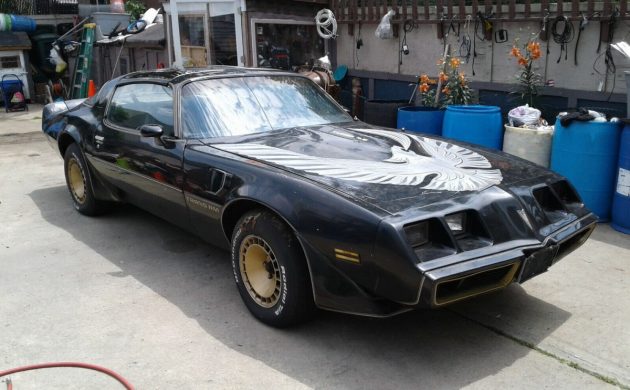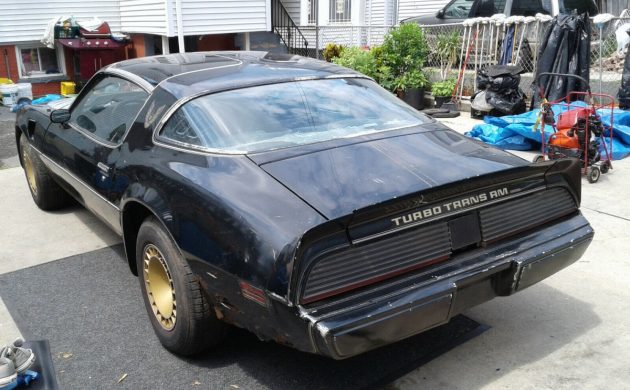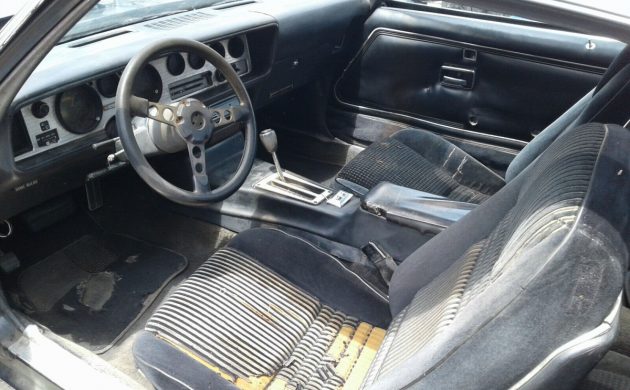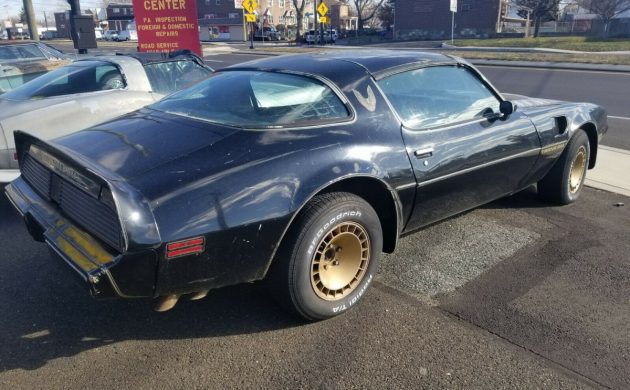When is a Trans Am Turbo not a Trans Am Turbo? When someone removes the turbocharged engine and slots a 350ci Chevrolet V8 in its place. That’s what the owner of this 1980 Trans Am has done, and I know that there will be people out there who will breathe a sigh of relief. However, the option is available to reinstate the car’s turbo credentials, and that will ultimately come down to individual tastes and preferences. Located in Newark, New Jersey, you will find the Trans Am listed for sale here on eBay.
There is no hiding the fact that the new owner will have some rust to address in this car, which is not that uncommon in a Trans Am of this era. There’s rust visible in the fender on the driver’s side, in the top near the T-Top, in both quarter panels, and around the trunk lid opening. There is also a significant amount of rust in the floors, but none of this is beyond repair. Thankfully, the car looks complete, but I guess that how this restoration is tackled will depend on either financial viability, or whether the new owner is fixated on owning a Turbo.
The concept of a turbocharged V8 engine at Pontiac started as a student project that was undertaken by automotive engineering students at the General Motors Institute in Flint. The original target engine was Pontiac’s 350ci engine, but by the time the concept was completed, the 350 was out of production. Pontiac engineers then adapted the concept for use on the 301ci engine and ended up with an engine that was running 9psi of boost on a modified and strengthened 301. The concept was fine, but motoring journalists of the era noted issues with pre-ignition, and also found difficulty in achieving consistent performance figures from the car. In spite of having a 20hp advantage over the manual Camaro Z/28, the automatic only Trans Am consistently posted slower acceleration times than the Z/28. The owner of this Trans Am has ditched the 301 in favor of a Chevrolet 350ci V8. The car is also fitted with power steering, power 4-wheel disc brakes, and factory air conditioning. The owner says that the car runs and drives. He also says that if the new owner wants to return the car to its original specifications, he does have a date-correct 301 Turbo engine and matching transmission, although he doesn’t indicate whether this will be included in the sale, or if it’s available at extra cost.
The interior of the Trans Am looks quite tired, and it is going to need a fair bit of work, from addressing the crack in the dash pad, the shredded covers on the seats, through to missing items like the armrests that are missing off the doors. There are some nice optional and comfort items fitted to the car, including a tilt wheel, cruise control, power windows, power locks, and a power trunk release.
In its day, the Trans Am Turbo was a much-maligned vehicle, and even today, there are people who simply won’t accept them. However, nice examples seem to perform well in the market. Between the standard Trans Am and the Indy Pace Car versions, sales of the Turbo models in 1980 accounted for nearly one-third of all Trans Am sales. Today, a good example will set you back somewhere in the region of $30,000 or more, but there are cheap project-grade cars out there. At the time of writing, bidding is sitting at $3,500, and the reserve has been met. So, would you consider owning a Trans Am Turbo, or are they are a car that you’re no fan of?





I could never decide if I like the Turbo wheels or Honeycomb wheels more…
I know what you mean. The Honeycomb wheels were designed to be decorative and very attractive. The Turbo wheels were designed to be more functional, as they helped to extract hot air from around the brakes. I like the Honeycomb ones more, but I understand why the Turbo ones were made that way.
I think I’d go with the honeycomb’s also, but the turbo wheels have a subtle look that is appealing, especially on a white car. Functional is a plus also.
I don’t blame the guy for wanting to ditch the turbo. We sold a few of these (4 if I recall correctly) with the turbo 301 and I doubt if any of them kept the turbo. I know 2 that got switched to a Pontiac 400 and a third that the 2nd owner got the parts to do away with the turbo and run a simple 4bbl. Stalling, inconsistent idle speed, and detonation were the main problems. I might add that we sold some Buick’s with the 231 V6 that were troublesome. Too much emission control on an otherwise reliable unit. And the European stuff gave problems too. My cousin bought a Porsche 930 that collapsed many pistons and ruined the cylinders. I thought that was an isolated case until my interim boss bought one, only to have the same problems. I’m starting to think that the only gas engine to survive a turbo was the Corsair…
I just sold a 1987 Buick Grand National when I bought it there was 45000 thousand miles on it.l put bigger cam and turbo on and drove it hard sold it not long ago with 172000 miles on it and it still runs strong. Dean
Fall 1978(probably) local Pontiac dealer gets the first 79 turbo in stock with same paint scheme as this one. My buddy’s dad is a doctor. The dealer thinks that Dr. should but this for my high school age buddy. Dealer lets me and buddy take it out on a test drive. New car was okay. Dr. said sorry son but not going to buy it for you. Two days later we go past the dealership and the car is gone. We stop in to congratulate the dealer (really just sucking up so that he’d let us drive more new cars). Dealer said that the car wasn’t sold. It was in the shop getting a new turbo installed…. Did WE burn out that turbo? Can’t say if we did or not but we felt pretty bad about it. Later in life I realized that Pontiac paid for the turbo under warranty but still. Not a very good selling point when the turbo lasted all of one test drive. And for the curious among the readers- no we weren’t pounding the car on the drive 😬
Not sure. No offense, but I’m not sure if anything about that story was true. First, the turbo trans am didn’t show up until 1980. Secondly, I’ve owned multiple turbo cars. These turbo chargers had no problems what so ever. With normal maintenance, they would routinely go 80,000 miles. Also, nothing goes wrong with a turbo charger except the bearings wearing out. You can’t do that with anything other than mileage or no oil. I think there may be a little exaggeration or creative memory going on here. Good story though.
Turbocharge the 350, problem solved.
I like the 8 inch snowflake wheels that came on the 78-79 ws6’s better than the turbo wheel. Pontiac killed the trans am when try went with the 301 turbo. Without electronic fuel injection the turbo didn’t help much. The 79 w72 cars were the last of the decent t/a in opinion,
Blame it on mandatory emission control and fuel consumption. There was a bunch of people who didn’t know goose crap from wild honey making regulations about what levels HAD to be met. Then the bean-counters put limits on how much to spend. The designers did everything they could with what was available, and in the time that was allotted. A good friend of the family was a designer for Chevrolet division and let’s just say that he worked hard for everything he got…
If you could buy it for $5G or less you could make a decent car out of it. I recall reading that the Turbo Trans Am featured in one of the Bandit sequels had a 350 transplanted into it just to get through filming. Buy the car, clean it up, then drop whatever motor and trans your heart desires.
Don’t know where you heard that, but it’s total b.s.. All the cars in S. And the B. 2, were bone stock. One had exhaust removed to make it louder, but they were otherwise untouched.
Always liked that Turbo hood even though it’s not centered. Im assuming to make space for the Turbo. Ha
It would be fun to swap a Grand National engine in this, just to keep it “turbo” — since the base Firebirds at this time already used the Buick 3.8 V6, it probably wouldn’t be THAT difficult to accomplish.
(And GM did this themselves sometime later!)
Be more fun to swap in a 650-hp LT4 crate engine.
I love the 78 and older T/As but really dislike this style because of that front end.
I think the concept of a turbo V8 was pretty bold for that time and probably would be worth saving if a better controller and maybe even fuel injection was added (Holley Pro-Jection?). The factory device that controlled the turbo was too limited by the technology at the time. It had a really basic sensor that listened for knock and constantly retarded the ignition. Car magazines couldn’t get a consist acceleration run because it would run good one time and poor the next time as the controller would dial the advance back as the engine got hotter.
My frend had one 1981 301ci turbo and hes opel gsi 1.8L 4cylinder
was faster so we puled to motor replace it with a 350ci problem solved
Had 1980 TURBO, WHAT A DOG. mY 50 bUICK COULD BEAT IT FROM A DEAD START. sHOUH HAVE4 HAD A SUPER CHARGER. IN IT.
Side scoop = Turbo. I had an 81. Sad story.